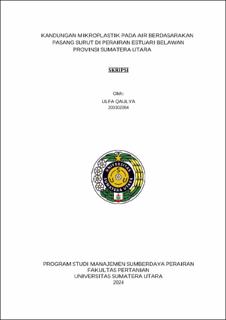Kandungan Mikroplastik pada Air Berdasarakan Pasang Surut di Perairan Estuari Belawan Provinsi Sumatera Utara
Microplastic Content in Based Water Tides in The Waters of The Belawan Estuary North Sumatra Province

Date
2024Author
Qaulya, Ulfa
Advisor(s)
Muhtadi, Ahmad
Fadhilah, Amanatul
Metadata
Show full item recordAbstract
Estuary waters are one of the water areas that are not free from rubbish. Belawan estuary waters are one of the estuary waters in Indonesia where semi-enclosed waters have a level that is susceptible to changes due to activities in the waters forming a transition zone between the river environment and the marine environment which is influenced by the sea such as tides, waves and influences from rivers such as river flow and sediment transport. Microplastics are plastic particles whose diameter is less than 5 mm. The aim of this research is to determine the form and amount of microplastics in the Belawan Estuary Waters. To find out the comparison of microplastic abundance between stations in the Belawan Estuary Waters. And to analyze the relationship between tides and the amount of microplastics in the Belawan Estuary Waters. This research will be carried out in October 2023 with 8 stations being studied. This research includes sampling, measuring physico-chemical parameters of waters, testing and analyzing samples in the laboratory and data analysis. The results obtained were that there were 5 types of microplastics that had been identified spatially and temporally. These types consist of fiber, fragments, film, pellets and foam. The highest temporal abundance was during the Full Moon at high tide as much as 916.67 particles/m³ and at low tide 784.4 particles/m³, and the lowest level of abundance was in the First Quarter phase at high tide as much as 493.3 particles/m³ and at low tide 454.4 particles/m³. The highest spatial abundance of microplastics was at Station VII at high tide, 507.78 particles/m³ and at low tide, 406.67 particles/m³, and the lowest level of abundance was at Station VIII at high tide, 275.56 particles/m³ and at low tide, 203.3 particles. /m³
Collections
- Undergraduate Theses [792]
